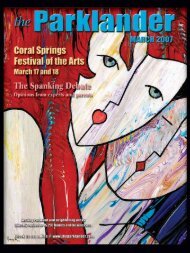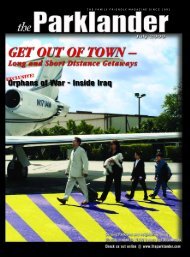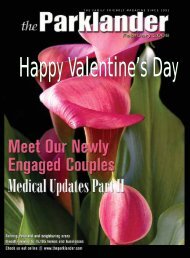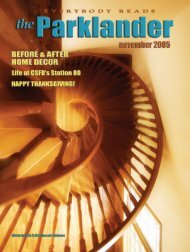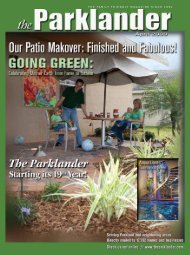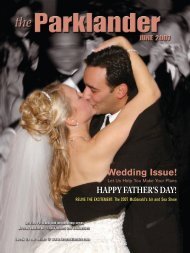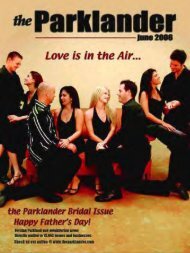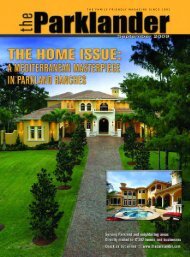September 2008 - The Parklander Magazine
September 2008 - The Parklander Magazine
September 2008 - The Parklander Magazine
You also want an ePaper? Increase the reach of your titles
YUMPU automatically turns print PDFs into web optimized ePapers that Google loves.
ARTS&ENTERTAINMENT<br />
By Bill Johnson<br />
F“For an artist, doing creative work for Disney World is like painting for<br />
the Pope during the Renaissance,” says Dan Daddona as he describes<br />
his feelings about the state of his artistic career and the development of<br />
his business. But that’s exactly what he’s doing - creating things such as<br />
huge life-like creatures and realistic fiberglass trees, the kinds of things<br />
that captivates us at Disney World and Epcot Center. <strong>The</strong> work is the<br />
culmination of nearly 35 years of experience, successful projects and a<br />
hard-earned reputation.<br />
At Daddona Studios on NW 16th Lane in Pompano Beach, Dan is<br />
busier than a one-arm wallpaper hanger, as they say. Fourteen employees<br />
are at work designing and building amazing interiors for a wide range of<br />
businesses – restaurants, medical offices, retail stores, nightclubs,<br />
museums, malls, entertainment centers, theme parks and what could be<br />
called “theme rooms” for the rich and famous. “What we do,” Daddona<br />
says, “is theme interiors.”<br />
<strong>The</strong> studio is more than an art studio; it is a manufacturing plant. On this<br />
day, one of the most imposing objects in the space is a fiberglass octopus,<br />
the body of which is about 50 feet across.Tentacles more than 15 feet long<br />
are being attached. On a tour of the shop, Daddona explains that the huge<br />
octopus was first carved from foam and covered with fiberglass. <strong>The</strong><br />
tentacles are designed and built to be moving parts –<br />
a specialty called “animatronics.”<br />
<strong>The</strong> octopus is one element in Daddona’s most challenging project,<br />
designing and building the theme elements for a 20,000 square foot<br />
restaurant in Kansas City, Kansas, called “T-Rex.” Twelve-foot jellyfish<br />
were made of transparent material and include more than a thousand<br />
strands of optical fiber. <strong>The</strong> wings of two pterodons stretch nearly 30<br />
feet and are translucent so that light can pass through.<br />
In the studio’s manufacturing space, huge, realistic styrofoam and<br />
fiberglass trees are taking shape and are stacked against a wall. Daddona<br />
stops to talk with a craftsman about how they’re going to create “moss”<br />
on the trees and how they’ll create the texture of bark. A large rowboat<br />
or skiff is taking shape and will find its way to a theme restaurant that is<br />
among Daddona’s clients. Stacked in a corner of his office are the molds<br />
of several octopus tentacles that wrap around the hostess station at the<br />
Living Seas restaurant at Epcot Center.<br />
To do all this, Daddona’s team needs a variety of skills.<strong>The</strong>y make molds,<br />
they sculpt, they do fine carpentry and metal work. For some projects,<br />
Daddona believes they’ve done things that have never been done before.<br />
Describing various projects, Dan Daddona talks fast and takes – or makes<br />
– constant phone calls necessary to run a thriving business, much of which<br />
has little to do with art. On the telephone, he’s asking about federal workplace<br />
safety requirements because he wants to have the proper mechanical<br />
lifts to install a several-hundred-pound octopus over a shark tank.<br />
64 SEPTEMBER <strong>2008</strong>



